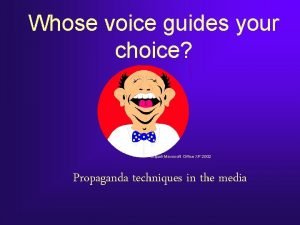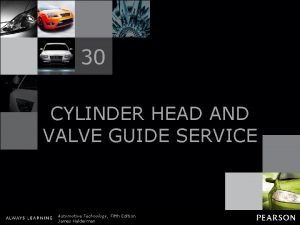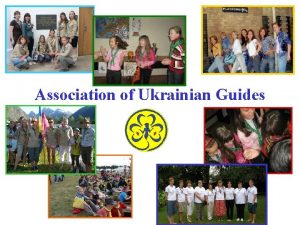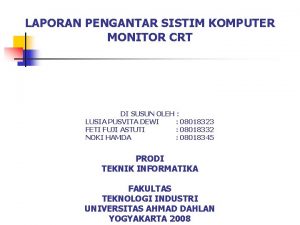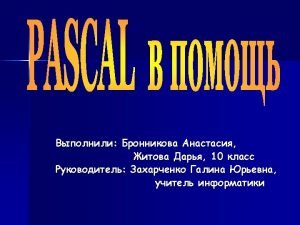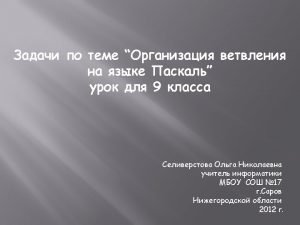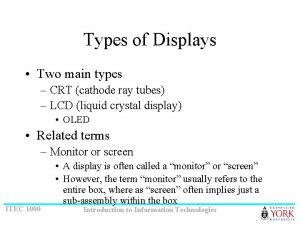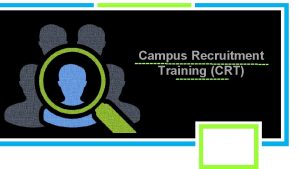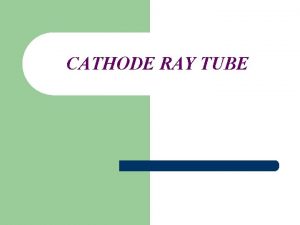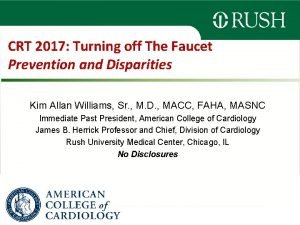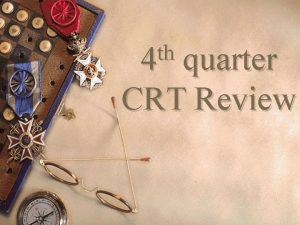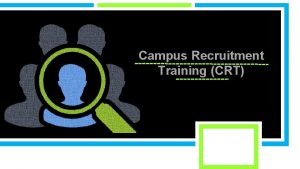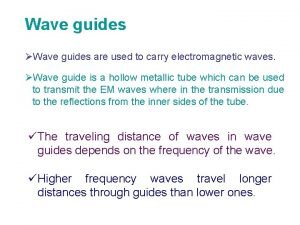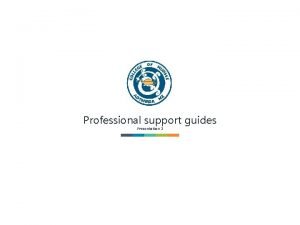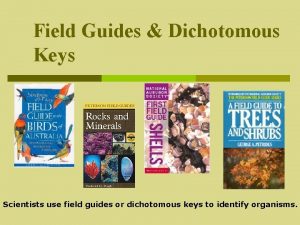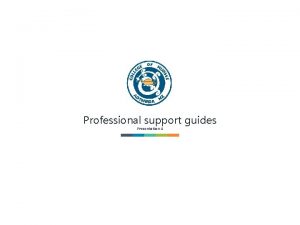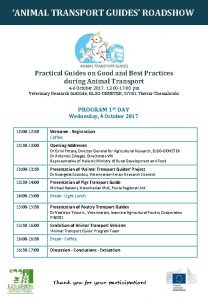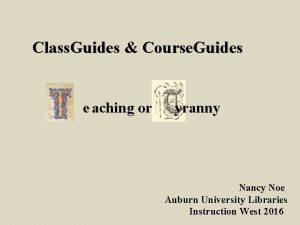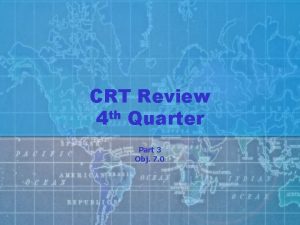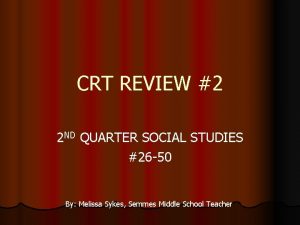2 ND QUARTER CRT STUDY GUIDES 1 What































- Slides: 31

2 ND QUARTER CRT STUDY GUIDES

1. What effect do animals have on the environment? • They release carbon dioxide into the atmosphere.

2. A puppy chews on objects other than food. This type of behavior is • An inherited innate behavior

3. Pheromones are released by an organism that • Affect the behavior of other animals of the same species.

4. A change in ocean current causes the climate on an island to become drier. As a result, the grasses that cover the island change from dark green to light brown. Over time, how might a species of green toads that hide in the grasses and are subjected to predation respond to these changes? • Their coloration will change to brown.

5. When effective insecticide is used on a population of insects, most of the insects are killed. However, a few may survive due to genes that make the resistant to the insecticide. What is the BEST explanation of why this occurs? • Insects that survived sprayings passed their resistant genes to their offspring.

6. Snowshoe hares experience a change in fur color from brown in the summer to white in the winter. Which statement best describes how the appearance of a particular snowshoe hare may change after it lives in a warm climate year-round, for many generations? • It would have brown fur all year long.

7. Less than ten thousand years ago, environmental changes separated some individuals of a squirrel population to one side of the Grand Canyon. Today, these squirrels now show a white tail and black belly. Their ancestors exhibited gray tails and white bellies. This difference in fur coloring most likely • Is evidence of speciation due to geographical isolation.

8. What is the end result of meiosis? • Four genetically different cells are formed

9. How does the number of chromosomes in egg and sperm at the end of meiosis compare with that in body cells? • They have half the number of chromosomes

10. Which student correctly identified the number of chromosomes in each organism? Gypsies Moth Guinea Pig Diploid Haploid 1 40 20 25 50 2 10 40 50 40 3 20 40 25 50 4 20 40 40 50 Student 3

11. What statement describes the beginning and end products of meiosis? • One diploid cell becomes four haploid cells.

12. The sperm cells of a squirrel have 20 chromosomes. How many are found in a body cell of the same animal? • 40 Chromosomes

13. How would a gene be described? • As the coded instructions for a trait

14. What is the function of the cell part labeled X? It contains the genetic instructions to control cell processes.

15. Which student has identified correct functions of a chromosome? Student 3

16. How will an organism be affected if part of its chromosome is missing? • The organism will lack the necessary information to control cell processed.

17. If a scientist is trying to decide if a molecule is RNA or DNA, for what should he test? • Thymine

18. The order of bases along a gene determines the order in which • Amino acids are put together to form a protein.

19. What is the function of RNA? • Copy the coded message from the DNA and carry it into the cytoplasm.

20. What nucleic acids are present in both DNA and RNA? • Guanine and Adenine

21. A DNA molecule is being transcribed onto a RNA molecule. The next base to be transcribed on the DNA sequence is adenine. Which base will be the complement in the RNA molecule? • Uracil

22. Which strand must be DNA, and not RNA?

23.

24. A science student was asked to construct models of DNA and RNA sections. Which section is correctly constructed and should be placed into a DNA strand?

25. When does a mutation occur? • When there is a change in the order of the bases in an organism’s DNA

26. A pea plant has alleles for green and yellow seed colors. According to Mendel’s law of segregation of characteristics, what must a gamete of the plant carry? • Only one allele

27. A pea plant has white flowers and yellow seeds. What does Mendel’s law of independent assortment say about these traits? • Inheritance of one trait does not affect the other.

28. In a cross of parents that are pure for contrasting traits, only one form of the trait will appear in the next generation. Offspring that are hybrid for a trait will have only the dominant trait in the phenotype. This is an example of which of Mendel’s laws? • Law of Dominance

29. In a plant, tall (D) is the dominant allele. Short (d) is the recessive allele. Which GENOTYPE would a short offspring have? • dd

30. Be able to interpret a pedigree chart MALES=SQUARES FEMALES=CIRCLE HAVE TRAIT=COLORED COMPLETELY IN CARRIER=HALF COLORED IN LINE CONNECTING TWO=MARRIED RCOMPLETE ROW=GENERATION
 Quarter and half
Quarter and half What's a quarter past 8
What's a quarter past 8 Unit meeting activities guides
Unit meeting activities guides Act 2 scene 3 othello summary
Act 2 scene 3 othello summary Wwc practice guides
Wwc practice guides Whose voice guides your choice
Whose voice guides your choice Smart guides adobe illustrator
Smart guides adobe illustrator Guide 111 erg
Guide 111 erg Unisa library guides
Unisa library guides God guides me
God guides me Cylinder head guides
Cylinder head guides Kde munis guides
Kde munis guides Iuss health facility guides
Iuss health facility guides The person who guides
The person who guides Association of ukrainian guides
Association of ukrainian guides Anticipation guide examples
Anticipation guide examples Cubs and bulbuls notes
Cubs and bulbuls notes Strategic retail planning
Strategic retail planning Pengertian monitor crt
Pengertian monitor crt Uses crt
Uses crt Viva quad xt
Viva quad xt Var a b integer
Var a b integer Uses crt
Uses crt Types of crt
Types of crt Helmet mounted display crt
Helmet mounted display crt Campus recruitment training topics
Campus recruitment training topics Crts ryles tube full form
Crts ryles tube full form Rsa crt calculator
Rsa crt calculator Crt graphics
Crt graphics Crt 2017
Crt 2017 Crt monitor
Crt monitor Crt electron gun
Crt electron gun





